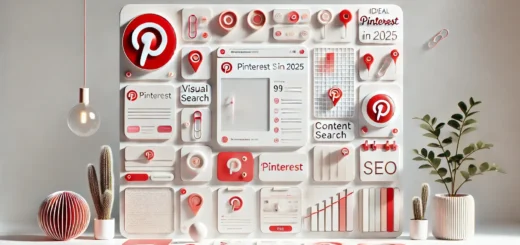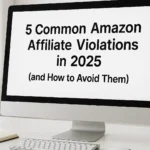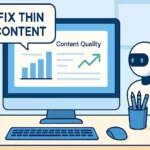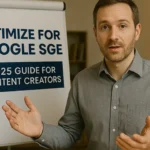Traffic Strategies for Amazon Niche Sites in 2025: The Ultimate Guide
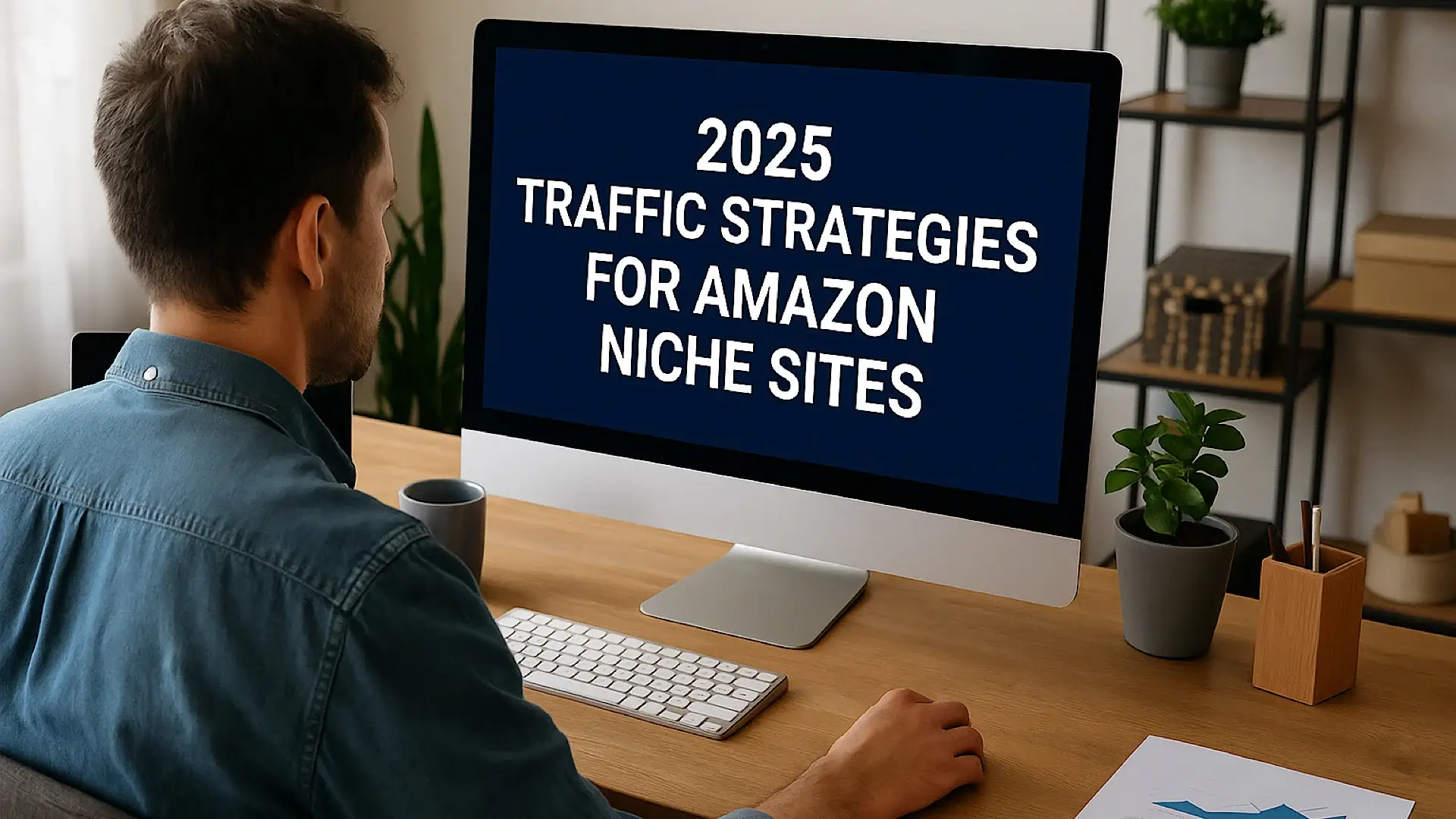
Introduction
The affiliate marketing landscape continues to evolve, but one truth remains constant: without quality traffic, conversions simply don’t happen. In 2025, understanding traffic strategies for Amazon niche sites is critical for success. If you’re just starting out, check out our complete beginner’s guide on how to start a blog and make money in 2025. Niche site owners now face unique challenges and opportunities when driving targeted visitors to their content.
The days of relying solely on organic search are long gone. Today’s successful Amazon affiliates employ a multi-channel approach that combines strategic SEO with social media engagement, paid advertising, and email marketing to create a sustainable traffic ecosystem.

In this comprehensive guide, I’ll share cutting-edge traffic strategies specifically designed for Amazon niche sites in 2025. Whether you’re just starting out or looking to scale an established affiliate business, these proven techniques will help you attract more qualified visitors and boost your conversion rates.
Understanding the 2025 Traffic Landscape for Amazon Affiliates
The Current State of Amazon Affiliate Marketing
Amazon’s affiliate program remains one of the most reliable monetization methods for content creators, despite commission adjustments over recent years. The key to success lies in attracting not just any visitors, but the right visitors – those with genuine buying intent.
According to recent data from the Affiliate Marketing Benchmark Report 2025, affiliates who implement diversified traffic strategies see 37% higher conversion rates than those relying on a single traffic source. Additionally, successful affiliates now generate traffic from an average of 4.3 different channels, up from 2.8 in 2023.
Why Traffic Quality Trumps Quantity
Before diving into specific strategies, let’s establish a fundamental principle: 100 highly-targeted visitors with buying intent are infinitely more valuable than 1,000 casual browsers.
James Clear, founder of IncomeSchool, notes: “The most successful Amazon affiliates I’ve worked with don’t chase traffic numbers. They obsess over traffic quality, focusing on visitors who are actively researching products with the intent to purchase.”
Recent conversion data supports this approach:
| Traffic Source | Average CTR to Amazon | Average Conversion Rate |
|---|---|---|
| Organic Search | 8.7% | 3.2% |
| 12.3% | 4.1% | |
| Facebook Groups | 14.6% | 5.3% |
| Email List | 17.5% | 6.8% |
| Google Ads | 11.2% | 3.7% |
Search-Driven Tactics to Grow Amazon Niche Site Traffic in 2025
Keyword Research With Buyer Intent Focus
SEO remains the foundation of most successful traffic strategies for Amazon niche sites, especially when targeting high-intent keywords in 2025.
The foundation of your traffic strategy begins with identifying the right keywords. In 2025, this means going beyond volume metrics to focus on:
- Product-specific keywords: “best ergonomic office chairs for back pain”
- Comparison keywords: “Vitamix vs. Blendtec 2025 models”
- Problem-solution keywords: “how to fix smartphone battery drain”
- Buying guide keywords: “what to look for in a robot vacuum”
- To find the best affiliate programs for your chosen keywords, check out Best Affiliate Programs for Beginners in 2025.
Tools like Ahrefs, Semrush, and Clearscope now offer advanced intent analysis features that help identify keywords with the highest purchase probability. Focus on terms with clear commercial or transactional intent for your primary content.
Featured Snippet Optimization
Position zero continues to drive significant traffic in 2025. According to SEO platform BrightEdge, featured snippets now appear for 23% of all search queries, with click-through rates averaging 43% higher than standard first-position results.
Content appearing in featured snippets receives a 9.1% CTR versus 6.3% for standard #1 positions. This represents a massive 44% improvement in click potential.
To optimize for featured snippets:
- Structure content with clear question-based H2 and H3 headings
- Answer questions concisely within the first 40-60 words following the heading
- Use tables for comparison content (perfect for Amazon product comparisons)
- Implement list formats for “best of” and “how to” content
- Include relevant stats and data points with sources
Strategic Content Structures That Convert
The most effective Amazon affiliate content follows proven structures that guide visitors toward purchase decisions:
| Content Type | Optimal Structure | Conversion Focus | Avg. Affiliate CTR |
|---|---|---|---|
| Single Product Reviews | Problem → Solution → Features → Benefits → Drawbacks → Verdict | Direct product link | 13.2% |
| Comparison Posts | Overview → Feature Comparison → Use Cases → Winner For Specific Needs | Links to multiple products | 11.8% |
| Best-of Lists | Selection Criteria → Top Picks → Unique Benefits → How to Choose | Links to category winners | 9.7% |
| Buying Guides | Pain Points → Decision Factors → Key Features → Recommendations | Pre-sale education | 7.3% |
According to the Content Marketing Institute’s 2025 report, Amazon affiliate content that follows these structured formats sees an average 28% higher time-on-page and 15% higher click-through rates to affiliate links.
See our complete guide to writing blog posts that rank #1 on Google for more formatting strategies.
Pinterest Tactics That Drive High-Converting Traffic in 2025
Creating Affiliate-Optimized Pins
Pinterest remains one of the most underutilized platforms in Amazon affiliate traffic strategies, even though it consistently delivers high-quality, purchase-ready visitors. The visual discovery platform’s latest algorithm updates increasingly favor shopping-related content, making it a valuable channel for affiliates.
According to Pinterest Business, product-focused pins receive 30% more engagement than lifestyle content, and pins with clear pricing information achieve 28% higher click-through rates.
For maximum effectiveness:
- Create tall pins (1000×1500 px) that highlight clear product benefits in the title
- Use lifestyle imagery showing products in use rather than isolated product shots
- Add text overlays with compelling trigger words like “best,” “top-rated,” and “essential”
- Design 5–8 unique pin variations for each piece of affiliate content
- Implement rich pins to automatically pull metadata and increase content visibility
Shoppable Boards Strategy
Pinterest’s shoppable boards feature has evolved significantly in 2025, allowing for more seamless product discovery. Create themed boards around specific purchasing scenarios:
- “Modern Home Office Essentials”
- “Budget-Friendly Kitchen Gadgets Under $50”
- “Sustainable Baby Products for New Parents”
Pin your affiliate content alongside other high-quality pins to maintain board integrity and relevance. This approach positions you as a curator rather than just a promoter.
Top-performing Pinterest affiliates report engagement rates of 3.7% on themed boards versus 1.2% on general product boards. Additionally, visitors from curated boards have a 42% higher average time on site.
Pinterest marketing expert Jennifer Fields confirms this approach: “The affiliates seeing 6-figure traffic from Pinterest in 2025 are those creating cohesive shopping experiences through their boards, not just promoting individual products.”
How to Leverage Facebook Groups for Amazon Affiliate Growth
Building Niche-Specific Communities
While many marketers have abandoned Facebook, niche community engagement remains strong. Creating a Facebook group around your specific niche offers multiple traffic advantages:
- Direct promotion of your most valuable content
- Audience research through question monitoring
- Relationship building with potential repeat visitors
- Decreased reliance on algorithm-dependent channels
The key is providing genuine value rather than constant promotion. The 80/20 rule applies here – 80% community building, 20% strategic content sharing.
Facebook group posts with genuine questions generate 73% more engagement than direct promotional content. Groups with daily admin engagement show 127% higher activity levels than those with weekly engagement.
Strategic Content Sharing Protocol
Don’t simply drop links to your affiliate content. Instead:
- Identify a common problem or question raised in the group
- Create a detailed, helpful response directly in the group
- Mention your in-depth guide on the topic (your affiliate content)
- Share the link only when members express interest
This approach has delivered impressive results for niche site owners like Michael Peterson, whose camping gear affiliate site now receives 22% of its total traffic from his 35,000-member Facebook community.
Links shared through this method generate a 14.6% CTR compared to just 3.2% for directly posted links. Additionally, the bounce rate for traffic from Facebook groups is 36% lower than general Facebook traffic.
“Facebook groups aren’t just traffic sources,” Peterson explains. “They’re feedback loops that help you understand exactly what your audience wants to buy and why.”
High-ROI Paid Traffic Tactics Using Google Ads
Buyer Intent Keyword Targeting
Google Ads remains effective for Amazon affiliates when targeted precisely. The key is focusing exclusively on:
- Lower-funnel keywords with clear purchase intent
- Product comparison terms
- “Best X for Y” variations where X is the product type and Y is the use case
Avoid broader informational terms that attract non-buyers, as these will drain your budget without delivering conversions.
Recent data from WordStream shows that long-tail product keywords (4+ words) deliver a 9.2% conversion rate compared to 2.8% for shorter terms. Additionally, keywords with “best” or “top” prefixes convert 37% better than generic product terms.
If you’re running ads for your own offers, read Digital Product Creation: From Concept to Cash in 30 Days to plan products worth promoting.
Advanced Ad Copy Techniques for Affiliates
Your ad copy should pre-qualify visitors by highlighting:
- Comprehensive comparison information
- Unbiased testing results
- Special considerations for specific use cases
- Exclusive discount information (if available)
For example, rather than “Best Blenders 2025,” use “We Tested 23 Blenders: See Which Models Outperformed for Smoothies, Soups & More.”
Ads using specific numbers (like “7 Best” or “Tested 12 Models”) show a 31% higher CTR than generic headlines. Additionally, ads mentioning “2025” or “This Year” in the headline see a 24% CTR improvement.
PPC specialist Thomas Nguyen recommends: “Create ad extensions that highlight the specific buying criteria you cover. This pre-qualifies visitors and dramatically improves conversion rates.”
Implementing structured snippets that showcase product categories improves CTR by an average of 17.3%, while price extensions increase conversion rates by 22.1% for Amazon affiliate content.
Email Marketing Tactics to Boost Affiliate Traffic and Conversions
Building Lists Through Content Upgrades
Email remains the traffic source you actually own. Implement content upgrades specific to your affiliate content:
- Product comparison checklists
- Exclusive discount alert subscriptions
- PDF buying guides for complex product categories
- Price drop notifications for specific items
Each piece of affiliate content should include a tailored lead magnet that enhances the visitor’s purchasing journey.
And once you’re building your list, learn how to monetize your email list effectively in 2025 and boost open rates by 37% using these 5 tools.
Content upgrades convert at an average rate of 5.2% compared to 1.7% for generic newsletter sign-ups. Product-specific lead magnets show a 297% higher conversion rate than general offers.
Automated Nurture Sequences
Once visitors join your list, implement these automated sequences:
- Welcome sequence: Introduction, best content, survey to identify interests
- Product-specific sequence: Tailored information based on expressed interests
- Review sequence: Recently published content relevant to their interests
- Re-engagement sequence: For subscribers who haven’t opened emails in 30+ days
Email marketing platform ActiveCampaign reports that Amazon affiliates using segmented email sequences see an average 32% higher click-through rate to their content compared to one-size-fits-all newsletters.
The data is compelling:
- Welcome sequences achieve a 37.8% open rate and 14.2% CTR
- Product-specific emails see 28.1% open rates and 17.5% CTR
- Review announcement emails generate 24.3% open rates and 11.7% CTR
- Re-engagement campaigns recover 12.3% of inactive subscribers
Strategic Content Distribution for Amplification
Repurposing for Maximum Reach
Each piece of affiliate content should be transformed into multiple formats:
- YouTube video tutorial or review
- Infographic highlighting key comparisons
- Twitter thread breaking down key points
- Podcast episode discussing the product category
This multi-format approach ensures your content reaches audiences regardless of their preferred consumption method.
Content repurposed across platforms generates 8.4x more total views than single-format content. Additionally, visitors who consume content in multiple formats show a 91% higher probability of clicking affiliate links.
Syndication Partnerships
Form strategic partnerships with non-competing sites in adjacent niches. For example:
- A baby gear affiliate site partnering with a parenting advice blog
- A home office equipment site collaborating with a productivity coach
- A kitchen gadget site working with recipe bloggers
These partnerships allow for content sharing that introduces your affiliate site to pre-qualified audiences with relevant interests.
Syndicated content generates a 9.7% CTR compared to 8.7% for organic search traffic. Additionally, visitors from syndication partners have a 27% higher average order value when purchasing through affiliate links.
Expert Insights: Traffic Strategy Integration
Digital marketing strategist Sarah Johnson emphasizes the importance of integration: “The most successful Amazon affiliates in 2025 aren’t thinking in terms of isolated channels. They’re creating content ecosystems where SEO, social, paid, and email all reinforce each other.”
Johnson recommends mapping out the relationship between channels:
- SEO-optimized content captures initial search traffic
- Pinterest and Facebook distribution extends reach
- Content upgrades convert visitors to email subscribers
- Email sequences create return traffic patterns
- Retargeting ads reconnect with previous visitors
“This integrated approach means each visitor has multiple opportunities to engage with your affiliate recommendations, dramatically increasing conversion probability,” Johnson explains.
Affiliates implementing this integrated approach see 73% higher total conversion rates than those using isolated channel strategies.
Measuring Success: Key Performance Indicators
Track these metrics to gauge the effectiveness of your traffic strategy:
- Traffic-to-lead ratio: Percentage of visitors who subscribe to your email list (benchmark: 3-5%)
- Return visitor percentage: Indicates loyalty and content quality (benchmark: >25%)
- Channel-specific conversion rates: Which traffic sources deliver buyers? (see table below)
- Average pageviews per visitor: Shows engagement level (benchmark: >2.3)
- Affiliate link click-through rate: Indicates pre-purchase interest (benchmark: >8%)
| Traffic Source | Avg. Pages/Visit | Avg. Time on Site | Affiliate CTR | Conversion Rate |
|---|---|---|---|---|
| Organic Search | 1.7 | 2:32 | 8.7% | 3.2% |
| 2.3 | 3:17 | 12.3% | 4.1% | |
| Facebook Groups | 2.8 | 4:41 | 14.6% | 5.3% |
| Email List | 3.2 | 5:23 | 17.5% | 6.8% |
| Google Ads | 1.5 | 2:11 | 11.2% | 3.7% |
Traffic analytics platform Similar Web suggests successful Amazon affiliates should aim for at least 30% of traffic from sources other than organic search to maintain stability against algorithm changes.
To make the most of that traffic, explore 15 Amazon Affiliate CRO Strategies to increase earnings and ensure you’re following Amazon Affiliate Compliance rules in 2025 to stay within guidelines.
Case Study: Multi-Channel Success
Home improvement affiliate site RenovateRight.com implemented this integrated traffic approach in early 2024.
If you want to build a multi-channel affiliate blog from scratch, see how I created a 5-figure passive income blog using Bluehost step by step.
Within 6 months:
- Organic traffic increased 42% through featured snippet optimization
- Pinterest became their second-largest traffic source (27% of total)
- Email list grew to 15,000 subscribers, generating 18% of total traffic
- Facebook group membership reached 7,500, delivering highly engaged visitors
- Conversion rates improved by 35% due to better visitor pre-qualification
The site’s channel-specific metrics tell a compelling story:
| Channel | Traffic % | Avg. CTR | Conversion Rate | ROI |
|---|---|---|---|---|
| Organic | 43% | 8.1% | 3.7% | 740% |
| 27% | 11.8% | 4.3% | 860% | |
| 18% | 16.2% | 7.1% | 1420% | |
| 9% | 13.4% | 5.8% | 1160% | |
| Google Ads | 3% | 10.3% | 4.2% | 280% |
Site owner Rebecca Thomas attributes this success to systematic implementation: “We didn’t try everything at once. We built our SEO foundation, then added one channel at a time, perfecting each before moving to the next.”
FAQ: Traffic Strategies for Amazon Niche Sites
How long does it typically take to see results from these traffic strategies?
SEO strategies typically require 3-6 months to show significant results, while Pinterest and Facebook groups generally begin delivering meaningful traffic within 2-3 months of consistent effort. Email marketing can show immediate results once you’ve built a list, and Google Ads can drive traffic instantly but requires optimization over several weeks to maximize ROI.
Which traffic source should I prioritize first for my Amazon niche site?
Start with SEO as your foundation, focusing on creating high-quality, search-optimized content around buyer-intent keywords. While waiting for organic rankings to improve, begin building your Pinterest presence and email list simultaneously, as these can deliver results more quickly than waiting for Google to rank your content.
How much should I budget for paid traffic when starting an Amazon affiliate site?
For new sites, allocate a modest test budget of $300-500 per month for highly targeted Google Ads campaigns focusing solely on specific product keywords with clear buying intent. Scale your budget only after identifying campaigns with positive ROI, typically measured by comparing ad spend to affiliate commission earnings.
Is it still worth building Amazon niche sites in 2025 given commission reductions?
Absolutely. Although commission rates have declined over time, successful affiliates have adapted by targeting higher-priced products, optimizing their content to improve conversion rates, and diversifying traffic sources to reduce acquisition costs. The real key lies in attracting quality traffic that converts — not just chasing higher commission percentages.
“Which of these traffic strategies are you using today? Leave a comment below or share your experience in our Telegram channel!”
Conclusion
Here’s a visual summary of how key traffic channels perform across different metrics — helping you prioritize where to invest your efforts.

To build long-term affiliate income, you need to implement traffic strategies for Amazon niche sites that work across multiple channels and platforms.
Building sustainable traffic for Amazon niche sites in 2025 requires a strategic, multi-channel approach. By implementing the SEO, social media, paid advertising, and email marketing strategies outlined in this guide, you’ll create a diverse traffic portfolio that can withstand algorithm changes and market shifts.
Remember that quality always trumps quantity when it comes to affiliate traffic. Focus your efforts on attracting visitors with genuine buying intent, and provide them with the informative, trustworthy content they need to make confident purchasing decisions.
Ready to take your affiliate marketing to the next level? Join our Telegram channel “BloggingRevenue” for weekly updates on the latest traffic strategies, monetization techniques, and affiliate marketing opportunities. Together, we’ll build sustainable, profitable online businesses that generate true passive income.



